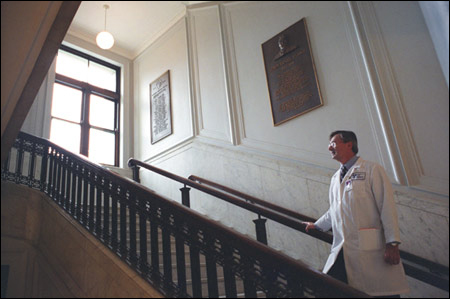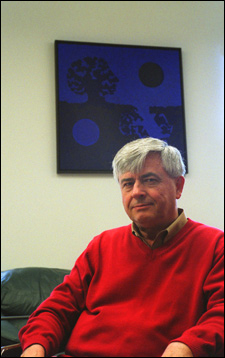New AIDS vaccine tested in U.S., Africa:
Trials in Boston, St. Louis, Botswana

Tests of a new vaccine against the virus that causes AIDS are being launched simultaneously in the United States and southern Africa. It is the first time that such a test will be conducted in the United State and Africa at the same time.
“In the past, we have tested the safety of drugs and vaccines in this country before beginning trials in other places,” says Max Essex, Given Professor of Infectious Diseases at the Harvard School of Public Health. “That involves a delay of a year and a half, something we want to eliminate.”
The government of Botswana, the nation with the highest rate of AIDS in the world, has agreed to the plan. “This study is a significant and hopeful step in Botswana’s battle against the scourge of AIDS,” says Joy Phumaphi, the nation’s minister of health. The disease affects more than one of every three adults in Botswana.
Most new cases of infection in Africa come from a different subtype of HIV than occurs in North America and Europe. “No one knows how important that difference will be in terms of vaccine development,” notes Essex. “Testing the vaccine in both places will provide a better understanding of how well it will work.”
The vaccine trials are being run by the Harvard School of Public Health and by the Harvard Medical School HIV Vaccine Unit, which includes sites at Brigham and Women’s Hospital and the Fenway Community Health Center in Boston, and at Miriam Hospital in Providence, R.I. The vaccine, known as EP HIV-1090, will be given to 36 healthy, uninfected volunteers between the ages of 18 and 40 years old who live in Boston, St. Louis, or Botswana. After 18 months, their health will be compared with six other people who received pseudo (placebo) injections.
The main objective of this test is to determine if EP HIV-1090 is safe.

Live viruses are not used in making the vaccine, so it cannot cause an HIV infection. Nevertheless, researchers must be sure the vaccine doesn’t cause toxic side effects, such as adverse reactions to the injections. Forty-two volunteers are enough to begin such a determination. If the vaccine raises no safety problems and it stimulates a protective response, then hundreds or thousands of people will be recruited to participate in tests of its ability to prevent HIV infection and AIDS.
Vaccination education
On May 27, President George W. Bush signed into law a bill to provide $15 billion over the next five years to fight AIDS in African and Caribbean countries. The plan mentions Botswana as one of the nations in greatest need. Meanwhile, the U.S./Africa vaccine trial is funded by the National Institutes of Health. Larger studies in the future could receive support from the $15 billion initiative. “We’ll need more help for education, treatment, and prevention programs in Botswana,” Essex points out. “We’ll need drugs to treat people in and out of the trials who become infected with HIV.”
The new vaccine, developed by Epimmune, a San Diego company, is assembled from small, synthetically produced pieces of HIV genes. The gene fragments are packed into so-called plasmids, or minute sacks, that are injected into a person’s blood.
Once inside blood cells, the DNA causes cells to make proteins that enable the body’s immune system to recognize pieces of infectious HIV and mount defensive attacks against them. If a vaccinated individual becomes exposed to the AIDS virus by having sex with an infected person, or using contaminated needles to inject drugs, the immunized cells attack any HIV-infected cells that enter the body. The process works much like other vaccines where the body repels live germs like measles and flu viruses.
Volunteers are now being tested to be sure they are free of HIV infections and whether they posses the tissue types necessary to mount an immune defense against the virus. Three different doses will be tested, each involving four injections over a six-month period. Eighteen months later, each individual will be examined to determine if the vaccine produced the expected immune response, one that should enable them to resist an HIV infection. Medical experts who do not know which people received the placebo and which the vaccine will compare the two groups.
“This vaccine approach is very promising,” says Ray Dolin, Maxwell Finland Professor of Medicine and principal investigator of the Harvard HIV Vaccine Unit. “The vaccine is relatively easy to make and very stable. If it proves safe and gives us a good immune response, we can proceed to test its efficacy in large numbers of people, including those who are at high risk of HIV infection.”
If these later tests prove successful, says Essex, “there’s a chance that the vaccine could slow down the growing pandemic that now causes millions of deaths each year among the 42 million people worldwide who have AIDS.”




